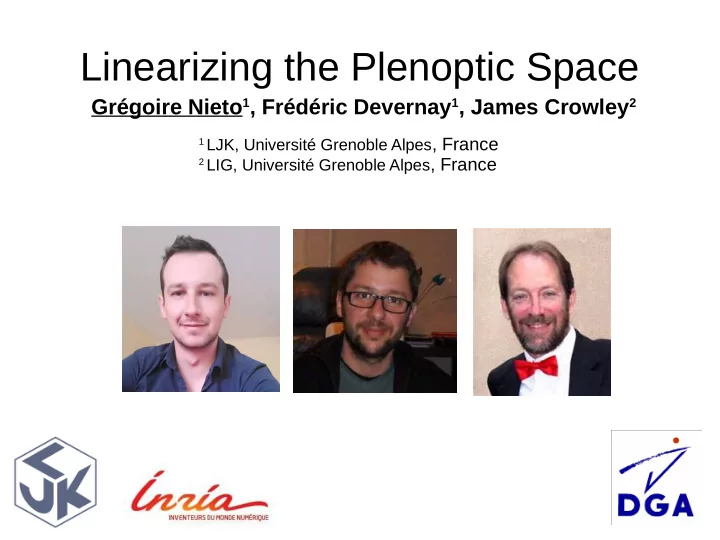

Linearizing the Plenoptic Space Grégoire Nieto 1 , Frédéric Devernay 1 , James Crowley 2 1 LJK, Université Grenoble Alpes , France 2 LIG, Université Grenoble Alpes , France 1
Goal: synthesize a new view ● Capture/sample the 4D space of rays. ● Use them to reconstruct the missing rays (geometry and color). ● Gold standard method: estimate a geometric proxy, warp rays. 2
Motivations ● Proxy reconstruction may be a very hard problem. ● Proxy error, refractions, specularities ⇒ rendering artifacts. ● Modeling refractions, specularities (BRDF) → assume particular capturing device and a priori knowledge of the material. ● Handle sparse/unstructured light field. ● Goal: not render but model for local light field behavior. 3 rendered image tarot ball – Stanford LF archive close-up – GT
Light Field Distortion ● Geometrical distortion (breaks the epipolar geometry). ● Violates the Lambertian assumption. ● Need for more complex geometric and photometric models. 4
Related Work ● Reconstructing reflective and specular scenes. P. Zhou et al. ICIP '13, ICIMCS ’14. Adato et al. PAMI ’10. A. Sulc et al. VMV '16. ● Reconstructing refractive and transparent scenes E. Iffa et al. SPIE '12. 5 G. Wetzstein et al. ICCV '11. K. Maeno et al. CVPR '13.
Key concepts ● Plenoptic space: space of rays, geometry (4D) and color (3D). ● Visual point : set of associated rays. Adelson et Bergen, '91 6
Light Field Representation Light slab parametrization, Levoy et Hanrahan '96. points 7 Epipolar Plane Image (EPI) input cameras
Reconstructing the Light Field model fitting by triangulation ● Geometric point model input cameras ● Photometric model 8
Overview of the Method ● Plenoptic space sampling. ● Ray parameterization. ● Model fitting. ● Model selection. ● Rendering. 9
Sampling the Plenoptic Space ● Ray correspondences: optical flow. ● For each visual point : set of rays (geometry and color). ● For each ray: uncertainty propagation. 10
Linearizing the Plenoptic Space ● Geometric and photometric linear models of the visual point: 3g, 4g, 6g, 3p, 9p. ● Weight each contribution by the propagated uncertainty of the measurement. ● Non-linear least square optimization : we maximize the likelihood of the parameters (probability of obtaining the data samples given the estimated parameters). 11
Model selection ● For each visual point, pick the right model without overfitting. ● Bayesian Information Criterion (BIC): + number of parameters + number of samples + final value of the cost function (likelihood of the estimated parameters). ● Chosen model: minimizes the BIC. 3g 6g 4g 12 result (3g + 3p) per visual point model selection
Rendering a novel camera ● Ray: Intersection between the reconstructed visual point P and the novel camera C . ● Color: deduced from the reconstructed ray and the fitted photometric model. 13
Results absolute difference fitting quality original image result 14
Results absolute difference fitting quality original image result 15
Results 16
Video 17
Summary ● Most IBR methods require geometric proxy. ● Proxy imperfections cause rendering artifacts. ● Estimating geometry: cumbersome and fails when: – Lambertian assumption violated. – Rays do not follow rules of parallax. ● Contribution: locally approximate the plenoptic space, captured from unstructured camera configuration, using visual points . ● Better reconstruction of specularities and transparencies. 18
Future work ● Fit non-linear models (quadratic). ● Include a temporal dimension (video, non-static scenes). 19
Recommend
More recommend